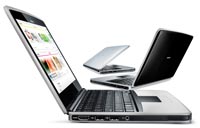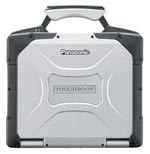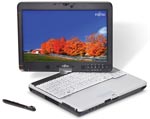In-Depth
Notebook Nation
Laptops and netbooks aren't just for road warriors anymore. Here's a look at just how big the portable-computer market is -- and the trends that are driving its growth.
- By Anne Stuart
- February 01, 2010
Tiny. Thin. Light. Stylish. Versatile.
While those keywords might sound like copy from a high-fashion catalog, they actually sum up the top trends in today's portable-computer marketplace. To that list, you might add a few automotive-marketing adjectives as well: Rugged. Powerful. High-performance.
Despite the downturn, that marketplace -- which includes everything from miniature "netbooks" to ever-slimmer desktop-replacement machines to "ruggedized" notebooks to innovative tablets -- is thriving. It's responding to both consumer and commercial demand for hardware that's either extra-small or extra-tough without sacrificing much, if anything, in terms of capability.
For partners focused on business customers, the message is clear: Notebooks and their brethren are no longer just road-warrior tools -- they're increasingly used by workers of every type, in companies of every size. (And that knowledge can open up a world of opportunity.)
 |
| As the netbook trend shows staying power, even mobile phone maker Nokia has gotten into the market with the Booklet 3G. |
Small Machines, Big Growth
Laptop sales have been growing for several years, first outstripping desktops in the retail market around 2005. By the second quarter of 2009, notebooks accounted for three of every four computers shipped to the U.S. market, according IDC's Worldwide Quarterly PC Tracker. By December 2009, IDC was crediting notebooks with driving the overall PC market back to positive growth after three consecutive quarters of declines. Worldwide, PC shipments for the third quarter rose 2.3 percent over the same period a year earlier. However, most of that demand came from the consumer market, where shipments jumped 33.5 percent over the previous year. At that time, the business market continued to lag as nervous IT managers put off new hardware purchases.
During 2010, IDC researchers expect to see overall portable-computer shipments increase by 18 percent. But this time, they say, growth won't be limited to the consumer side -- look for business sales to rebound in the second half of this year. "As commercial spending recovers in 2010, we expect to see robust growth over the next several years," Loren Loverde, director of IDC's Worldwide Tracker Programs, said in a press release announcing the findings. (However, the distinction between commercial and consumer spending is rapidly growing fuzzier; see "'B' vs. 'C': A Thin Line.")
The Death of SMB Brand Loyalty?
But take note: Commercial customers -- especially small and midsize businesses (SMBs) won't necessarily be doing that spending on the same brands they've bought in the past. In another IDC study involving more than 1,000 SMBs, 30 percent of small companies (which IDC defines as those with fewer than 100 employees) and more than 45 percent of midsize companies (those with 100 to 999 employees) planned to buy notebook computers by mid-2010.
But that June 2009 report also emphasized that "despite the growth of the SMB notebook market overall, brand loyalty among SMBs continues to wane." That's particularly true of the smallest businesses, according to the report authored by IDC senior research analyst Justin Jaffe: "With the exception of those that own Apple and Acer notebooks, less than half of small firms that own a given brand and plan to buy a notebook in the next 12 months plan to buy that particular brand again."
And some sobering news for the channel community, according to IDC: SMBs are most likely to make those purchases directly from manufacturers, typically ordering online rather than by phone or mail. "The overall strength of small-business channel loyalty has declined, and the total percentage of firms citing plans to buy PCs from the same channels they used in the past 12 months has decreased considerably since the previous IDC survey," the report stated.
 |
| Many portables now sport a stylish look, a feature that owes much to Apple Inc. laptops such as the MacBook Pro. |
Jaffe says that Dell Inc. remains the most popular notebook-PC brand among SMBs, with 40 percent of small-company respondents and 60 percent of midsize ones planning to purchase Dell machines this year. However, he notes that the HP-Compaq share of that market has "increased considerably" since IDC's last survey, and Apple notebook ownership is growing among SMBs as well.
IDC expects notebook brand and channel loyalty to continue declining, particularly among the smallest, most price-conscious companies. Jaffe's advice: Seize the opportunity. Develop an effective strategy for reaching the SMB notebook market. And don't take any SMB customers for granted.
The Enterprise View
Notebook use is on the rise at larger companies as well. In late 2008, Intel Corp. -- whose processors, including the new Atom platform, power many of the top notebook brands -- commissioned a Forrester Research Inc. study on the impact of notebook deployments in large enterprises. The study, which involved in-depth interviews with 322 PC decision-makers at U.S. and Canadian companies with 1,000-plus employees, found that:
- Notebooks are rapidly replacing desktop machines. At the time of the study, notebooks represented about 40 percent of all enterprise PCs, up from 25 percent in 2005. Forrester predicts that those percentages will pick up as more organizations encourage employees to work from home for both environmental and financial reasons.
- Notebooks are no longer limited to top executives and road warriors. Portable machines are increasingly deployed "across all spectrums of mobility and roles" -- including desk-bound workers who don't travel at all.
- Notebook users are more productive than those tethered to desktops. Notebook-equipped employees average 51 more minutes of work per day than comparative desktop users, according to the report. That's because notebook-users can access company applications and the Internet while away from their desks and can work outside regular office hours.
- Different notebook user groups need different notebooks. Researchers found that many companies segment their workers based on travel frequency -- for instance, road warriors (those who spent more than half their time traveling), heavy travelers (those who spend 25 percent to 50 percent of their time on the road), moderate travelers (those who travel less than 25 percent of the time) and light travelers (who rarely travel but sometimes work from home or another office). IT managers then outfit the workers accordingly.
Not surprisingly, Forrester researchers also found that enterprise IT managers' main concerns about moving to notebooks involved cost and security. Respondents said that notebooks were, on average, 37 percent more expensive than desktops to maintain. But they also cited several factors that could reduce those support costs, including better remote-management tools, reduced breakage rates and new anti-theft software and hardware tools. Still, 26 percent of respondents called the risk of hardware theft or security breaches too great to justify deploying additional notebooks.
What's Happening in Notebook Hardware
No question about it: Netbooks -- tiny, lightweight portable computers -- have been the hottest hardware trend in recent times. It's been just more than three years since ASUSTeK Computer Inc. of Taiwan rolled out its EeePC, a two-pound machine with a seven-inch screen and a price tag of less than $300. Since then, Acer Inc., Dell, Hewlett-Packard Co., Samsung and most other hardware vendors have rolled out their own mini-notebooks, selling upward of 20 million last year. Analysts expect PC manufacturers to ship nearly 140 million netbooks by 2013 (see "Spotlight on the Netbook," July 2009).
Early netbooks won rave reviews for their portability and price -- but also plenty of complaints about cramped keyboards, poor screen quality, low power and lack of storage space. (That original Asus model had a 4GB hard drive, 512MB of RAM and a 900MHz processor.) Initially, some speculated that these mini-notebooks might be marketed primarily to college students and parents of young children.
 |
| The Panasonic Toughbook 30 continues to define a pricier niche that other companies are moving into -- ruggedized systems. |
But manufacturers quickly ratcheted up the specs. Today, most standard netbooks include at least 1GB of RAM, 160GB of storage space and a 1.6GHz processor, along with more comfortable keyboards, higher-quality screens, more efficient batteries and other improvements that make them attractive to business users.
The HP Mini 5101, for instance, comes with a 10.1-inch screen and a keyboard that's 95 percent of normal size. It can be upgraded to include up to 2GB of RAM, 320GB of storage space and a long-life six-cell battery that's advertised as lasting up to nine hours. It also includes a built-in 2-megapixel webcam. At press time, the 2.9-pound Mini 5101 was retailing for about $425-$450.
Even Nokia, the Finnish mobile-phone company, has gotten into the netbook act. Nokia launched its first computer, the 2.75-pound Nokia Booklet 3G late last year, shipping it with the Windows 7 operating system. The features most likely to endear this machine to business users: built-in GPS, a protective aluminum shell and advertised 12-hour battery life. The Booklet 3G retails for $600 and up, although Best Buy was selling the machine for $199 to $299 with a two-year contract for AT&T wireless data service.
Meanwhile, regular-sized notebooks are also following the thinner-plus-lighter-equals-better formula. The full-size Toshiba Satellite T135-S1310, for instance, weighs less than 4 pounds and measures 1.4 inches thick -- and, in a stylish touch, is available with a red or white high-gloss coating. But when it comes to performance, this machine isn't lightweight, according to independent reviewers who say its dual-core SU4100 processor stands apart in the thin-and-light category. (Retail price is around $700.)
The new Acer TravelMate Timeline series, announced in December, also reflects the demand for ultra-light, ultra-slim notebooks. The Timeline 8571, 8471 and 8371 all tip the scale at about 3.5 pounds and measure about 1.1 inches thick. Like Nokia, Acer hopes to win business-users' hearts with an extended battery life of up to 8 hours (Retail prices are in the $850-$1,000 range.)
 |
| The Fujitsu Lifebook T4410 represents the current state-of-the-art for laptop-tablet convertibles. The industry is eagerly awaiting a tablet entry from Apple Inc., which was characteristically hoarding details prior to launch. |
On the other end of the notebook spectrum, there's continuing demand for computers that can survive some manhandling and use in harsh, dirty or wet environments. The Panasonic Toughbook line is probably the best known in this rugged-notebook category, but other vendors are moving into this market as well. One high-profile example: the Dell Latitude E6400 XFR, which Dell says is built to military standards and "can withstand pounding rain, blowing dust and dirt, extreme temperatures [and] accidental drops" of up to 4 feet. That's not hyperbole, according to reports by independent testers who said the machine still worked after being covered with dirt, drenched with water and dropped on the floor. (Dell says a tablet-style version, the Latitude XT2-XFR, is equally durable.) But all that armor doesn't come cheap: A fully tricked-out E6400 XFR sells for more than $5,100.
Finally, there's the tablet notebook. It's hardly a new concept: Vendors were experimenting with "pen computers" as early as the 1980s. During his annual Comdex keynote address in 2001, Microsoft Chairman Bill Gates demonstrated several prototypes for notebook-sized tablets, saying that he already used one as his own personal computer and predicting that "within five years ... [the tablet] will be the most popular form of PC sold in America."
That level of adoption didn't happen in the United States -- or anywhere else. However, some manufacturers -- including Acer, Fujitsu, Lenovo Inc. and Toshiba, among others -- have steadily added feature-packed tablet models to their product lineups. Among the most recent entries: the Fujitsu Lifebook T4410. Introduced in October 2009, the 4-pound "convertible" -- or laptop-tablet combo -- has won praise for its 360-degree rotating display, its touch-screen controls and its handwriting recognition capability.
Now, though, interest in tablet notebooks is heating up again, thanks largely to news that Apple Inc. will unveil a tablet computer early this year. Few details were available at press time -- even the product's rumored name, iSlate, was unconfirmed. But industry observers say the Apple mystique -- and the unparalleled success of its iPhone -- could do what once seemed impossible: make the tablet computer sexy again.